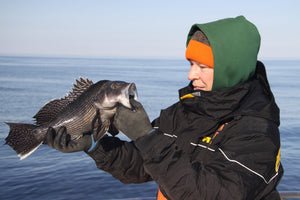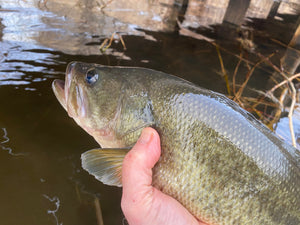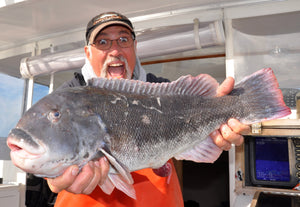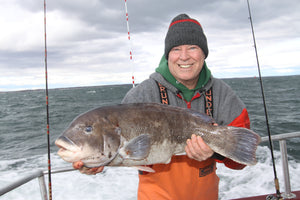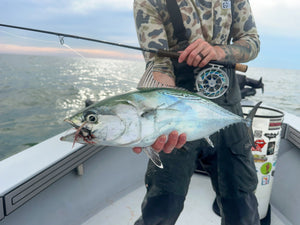Super Fall Sea Bass
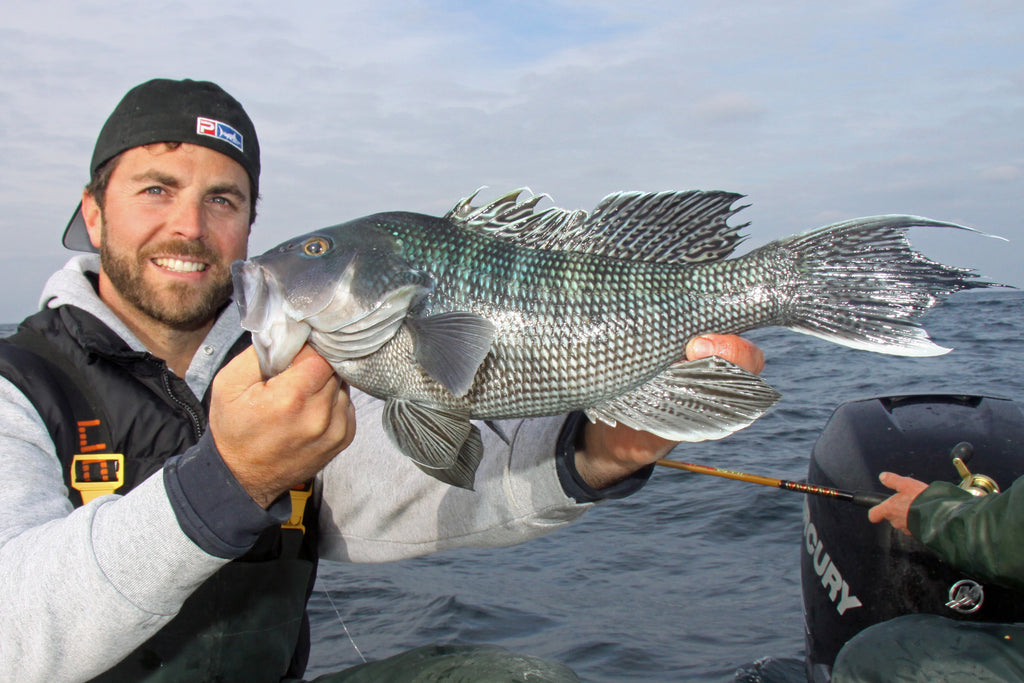
Sea bass are an "everyman's fish;" numerous, cooperative, available up and down the east coast, and often found close to port. You can catch them in ten feet of back bay water during the fall months or offshore in 60 to 150-foot depths and greater during almost any time of the year. Either way, they'll put up a good scrap if taken on suitable tackle and they'll keep you entertained with the kind of fast-biting action that stretches huge smiles across tired faces at day's end.

Calm day are perfect for seeking out and anchoring over smaller pieces of wreck or reef that other anglers overlook. These pieces tend to see less pressure during the season and reload faster after being fished. OutdoorTom.com photo.
NY State saltwater fishing regulations for sea bass vary from summer to fall and generally seem to be in a state of flux from year to year, so it’s important to give them a check before heading out. This year (2022), for example, the minimum size is 16 inches. Anglers were able to keep only three per day from the season opener on June 23 through August 31, but they can keep six each from September 1 through October 31. As a rule, the fall season is considered prime time for icing the biggest, knob-headed sea bass, some of which can top 5 pounds in weight.
To know the sea bass is to catch the sea bass, so a little background information seems to be in order. This species is a member of the grouper family Serranidae. Like many of its close cousins, sea bass are protogynous hermaphrodites and sexually dimorphic. In layman's terms, this simply means small fish are usually lassies but turn into lads as they grow older. Thus, any large sea bass you catch are probably males.
The older a sea bass lives to be, the more territorially aggressive it becomes. Big sea bass tend to school with big sea bass, and the reverse is also true. Therefore, if you find yourself over a mess of small fish, you might want to consider picking up the anchor and heading off to another spot rather than catching shorts all day long. On the flip side, if your first couple of sea bass are solid fish, the odds are that the rest will be as well.
Big sea bass are really interesting to examine up close. Look at a one immediately after you've caught it and you'll see it has the eye of the tiger and the chiseled, no-nonsense face of a veteran gladiator. Indeed, big sea bass have character. As they push over the 2-pound mark, they develop a nasty-looking humped back, facial stripes and a florescent green or white mottling that looks outrageous when the sun strikes it just right. That cool, iridescent glow, however, quickly fades once their life force begins to drain, so if you want to take a picture of a sea bass it is best to snap the shutter before your trophy enters the cooler.
"Live bottom," is the key to finding sea bass. Like blackfish, this species makes its living by picking away at crabs, mussels, clams, sea worms, squid, small baitfish and a variety of small fodder that can be found wherever wrecks or rocky bottom abounds. The starting point for targeting sea bass, then, is finding some rough sea floor, although not as nasty as where you’d expect to encounter big blackfish. Think high profile wrecks, humps, mussel beds and ledges. These areas are especially productive if they also host some weeds and show a little baitfish “fuzz” on your recorder. If you find mussels stuck in the flukes of your anchor, you are definitely in the right place.

A nice, stringy piece of skimmer clam is all you need to hook-up with black sea bass. They will, however, strike a wide variety of baits and lures including crabs, squid strips, diamond jigs and bucktails so be sure to experiment if the bite slows down. OutdoorTom.com photo
Long Island’s South Shore reefs offer ideal black sea bass habitat. The problem is that most serious sea bass fans already know that so major pieces get hit hard. Thus, it can pay big dividends to move off a bit from the fleet and look for smaller, more isolated pieces of reefs that might not get hit as hard. If you plan to hit more popular spots, plan your trip for mid-week if possible so they have a chance to recharge from their visits by the weekend crews.
While you can get away using spinning gear when working relatively shallow water for sea bass, conventional gear and braided line is really a better choice as it offers more backbone and greater control. Figure you’ll need a medium-light to medium strength stick and reel spooled with 20- to 30-pound test braid to handle the 4- to 8-ounce sinkers that should suffice for most action. A nice sea bass combo that can pull double-duty in medium depths and deep water might run along the lines of a 7’ 6” heavy power, fast action St. Croix Mojo Inshore rod (JIC76HF) paired to a Daiwa Saltist HA Levelwind conventional reel loaded with Daiwa J-Braid 30-pound-test line. Step up to heavier gear if heading to deeper water and stronger currents well offshore. 
As far as the terminal end of your sea bass offerings are concerned, this is pretty standard bottom-fishing. Most anglers choose clam or strips of squid for bait. These are lowered to the bottom on a standard hi-low rig featuring a pair of size 2/0 to 4/0 beak baitholder style hooks to which you might want to add a hot pink or chartreuse skirt. Set the bottom hook six inches above the sinker and the high hook just far enough above the lower one so that the two will not touch. Get your line to the bottom, lock your reel in gear, and wait for the fun to begin. If you’d like to purchase pre-tied rigs, check out our Custom Hi-Lo Sea Bass/Cod rigs. Size 2/0 is as catch-all size that’s great for a mix of sea bass and scup. Size 4/0 is perfect when the sea bass are main focus, and size 5/0 or 6/0 is a smart choice for targeting larger sea bass in waters that may also see a few codfish inhale your baits.
Sea bass action should be in full swing throughout October, so make plans and get in on the fun. If you need a little help figuring out where to point your bow, stop by the shop and we’ll be sure to point you in the right direction. Be sure, however, to head out sooner than later as the winds of October often mean some lost days toward the end of the month.
- Bryce Poyer

